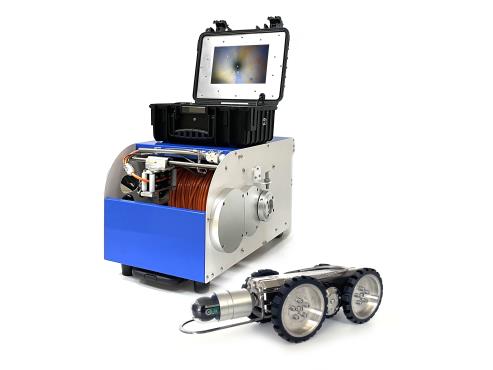核心关键词:sewer line inspection
Meta title:Innovations and Challenges in Modern Sewer Line Inspection | JIUTAI(67)
Meta desc:Dive into advancements and challenges in sewer line inspection technologies. Learn how they are transforming the efficiency and safety of sewer management.(155)
Exploring Innovations and Challenges in Modern Sewer Line Inspection
Sewer line inspection is crucial for maintaining public health and environmental safety, ensuring that waste management systems function efficiently and prevent pollution. Recent advancements in technology have significantly enhanced these inspections, introducing robotics, drones, and artificial intelligence into the mix. These innovations not only increase the accuracy and efficiency of inspections but also drastically reduce the risks involved, paving the way for more sustainable urban development.
How sewer line inspection technology develops
Traditionally, sewer inspections were labor-intensive and hazardous, requiring workers to physically enter sewers to assess conditions and identify issues. This method not only posed significant health risks but was also less efficient, with limited visibility and accuracy.
The use of CCTV (closed-circuit television) cameras, which allowed for remote visual inspections, marked a significant turning point. This not only improved safety by reducing the need for manual entry but also increased the thoroughness of inspections.
Overview of the latest tools and technologies
In recent years, the field has seen revolutionary changes with the integration of more sophisticated technologies.
- Robots: Automated robots are now used to traverse sewer lines, equipped with cameras and sensors that provide high-resolution images and data. These robots can navigate challenging environments and deliver real-time insights.
- Drones: Drones are being adapted for sewer inspection, especially in larger sewer systems where they can quickly cover vast areas. Equipped with protective casing and advanced navigation systems, drones can enter and inspect sewers with minimal human intervention.
- Artificial Intelligence (AI): AI and machine learning algorithms analyze the massive amounts of data collected by robotic and drone inspections. This technology helps in predicting potential failures and scheduling proactive maintenance, making sewer management more predictive than reactive.
This technological evolution continues to transform sewer inspections, making them safer, faster, and more data-driven, ultimately contributing to smarter city management.

Advanced technologies and tools for sewer line inspection
As we dive deeper into the technological realm of sewer management, let’s explore the modern tools that are currently leading the way.
Detailed look at CCTV robotics
CCTV robotics have become a cornerstone in modern sewer inspection due to their efficiency and safety benefits. These robotic systems are equipped with high-definition cameras and are controlled remotely, enabling them to navigate through sewer lines and capture detailed footage of the sewer’s interior. This footage helps identify cracks, blockages, and other structural issues without the need for direct human intervention. The mobility of these robots is continually improving, with enhancements like 360-degree camera rotation and better obstacle navigation, which allow for comprehensive inspections of even the most complex sewer systems.
JIUTAI Technology provides various models of crawler robots for sewer inspection, allowing for more convenient and economical sewer management.
The role and capabilities of drones in sewer inspection
Drones are increasingly being recognized for their potential in sewer inspection, particularly in inaccessible or hazardous areas. These drones are typically waterproof and equipped with powerful lights and cameras. They can provide a bird’s-eye view of large sewer sections, making it easier to spot issues like leaks and obstructions. The agility of drones makes them ideal for rapid assessments, significantly cutting down the time required for a full sewer inspection. Additionally, drone technology continues to advance, incorporating features such as automatic damage detection and the ability to operate in autopilot mode within confined spaces.
The impact of artificial intelligence and machine learning
Artificial Intelligence (AI) and machine learning (ML) are reshaping how sewer data is analyzed and utilized. These technologies process the vast amounts of data collected by drones and CCTV robotics to detect patterns and predict potential problems before they become critical. For instance, AI algorithms can analyze years of inspection footage to identify trends in wear and tear, helping prioritize maintenance schedules and resource allocation. Machine learning models are also being developed to automatically identify and classify types of sewer defects from images, streamlining the inspection process and reducing the potential for human error.
These advanced technologies not only enhance the effectiveness of sewer inspections but also help in managing the vast infrastructure networks more proactively, ensuring longevity and reliability while minimizing risks and costs.
Challenges in modern sewer inspection
While the integration of modern technologies has transformed sewer inspection, it's not without hurdles. This section delves into the technical, operational, and financial challenges that municipalities and service providers face as they adapt to these high-tech tools. Let’s explore the barriers that could impede progress and consider how they might be overcome.

Technical challenges with new technologies
While the advancements in sewer inspection technologies bring numerous benefits, they also come with their set of technical challenges. The integration of sophisticated equipment like robots and drones into sewer environments often encounters issues such as technical malfunctions, data overload, and the need for frequent updates and maintenance. These technologies require robust waterproofing and resistance to harsh chemicals and conditions found in sewers, which can be difficult to achieve consistently. Additionally, the complexity of data gathered can overwhelm analysis systems without sufficient processing power or advanced algorithms. Therefore, choosing a reliable provider such as JIUTAI is essential, making sure that the equipment can perform soundly for the inspection.
Operational challenges in urban and rural settings
The operational challenges of implementing modern sewer inspection techniques vary significantly between urban and rural settings. In densely populated urban areas, the extensive and often aged infrastructure creates logistical challenges in terms of access and maneuverability. Conversely, rural areas might struggle with the availability of these advanced technologies due to smaller budgets and less infrastructure to support the deployment and maintenance of sophisticated inspection tools. Both settings require tailored approaches to integrate new technologies effectively, ensuring that all regions can benefit from improved sewer management.
Financial and training barriers
Financial constraints are among the most significant barriers to adopting new sewer inspection technologies. The high initial cost of advanced equipment, coupled with the need for ongoing maintenance and updates, can be prohibitive for many municipalities, especially those with limited budgets. Additionally, there is a substantial need for training personnel to operate this new technology effectively. Skilled operators are essential to maximize the benefits of advanced inspection tools, and without proper training, the effectiveness of these investments is greatly diminished.
These challenges underscore the necessity of continued innovation and adaptation in sewer line inspection, ensuring that the benefits of new technologies can be realized across different settings and overcoming barriers to their adoption.
The impact of innovations on urban sewer management
Innovations in sewer inspection technology are making a significant impact on urban sewer management. From enhanced efficiency and accuracy to improved worker safety and environmental benefits, let's explore how these advancements are reshaping the landscape of urban infrastructure maintenance.
Improvements in efficiency and accuracy
The adoption of new technologies in sewer inspection has significantly boosted both the efficiency and accuracy of these essential services.
- Faster Inspections: Advanced tools like CCTV robots and drones can cover more ground in less time, drastically reducing the duration of sewer inspections.
- Enhanced Accuracy: High-definition cameras and sensors provide detailed images and data, allowing for precise identification of issues such as leaks, blockages, and wear, which might be missed by the human eye.
Enhancements in worker safety
Innovations in sewer management also contribute markedly to worker safety:
- Reduced Exposure to Hazards: The use of remote-operated devices minimizes the need for workers to physically enter potentially dangerous environments, reducing exposure to harmful gases and bacteria.
- Less Physically Demanding: Automation of routine tasks decreases the physical strain on workers, lowering the risk of injuries associated with manual labor in challenging environments.
Environmental benefits
The environmental impact of modern sewer inspection technologies is profound and positive:
- Prevention of Overflows and Leaks: Early detection and precise maintenance help prevent sewage overflows and leaks that can lead to soil and water contamination.
- Resource Preservation: Streamlined diagnostics and focused maintenance minimize extensive digging and repairs, preserving natural resources and lessening the environmental impact of upkeep activities.
These advancements not only enhance the capabilities of those tasked with maintaining urban sewer systems but also contribute to broader societal and environmental benefits, showcasing the vital role of innovation in public utility management.
What is the future of sewer line inspection?
As we look ahead, the future of sewer inspection promises even more sophisticated technologies and innovative practices. This section will explore the emerging tools and trends poised to further revolutionize sewer management, and predict how these advancements could shape the next decade of urban infrastructure maintenance.

Technologies emerging for sewer line inspection
The future of sewer inspection is promising with several emerging technologies poised to further enhance capabilities:
- Advanced Sensory Technology: Developments in sensory technology, including enhanced chemical and biological sensors, will allow for more detailed analysis of sewer conditions.
- Augmented Reality (AR) and Virtual Reality (VR): AR and VR could soon provide engineers and technicians with immersive, real-time views of sewer systems, improving diagnostic accuracy and planning efficiency.
- Autonomous Robots: Further advancements in robotics, including full autonomy, are expected to increase the frequency and scope of inspections, making systems nearly self-maintaining.
Predictions for the next decade in sewer management technology
As we look to the future, several trends are likely to shape the landscape of sewer management technology:
- Increased Integration of AI and IoT: The integration of artificial intelligence with the Internet of Things (IoT) will enable smarter, more connected sewer systems that can communicate issues in real-time, predict failures, and schedule their own maintenance.
- Sustainability-Driven Innovations: With growing environmental concerns, technologies that minimize ecological impact while enhancing sewer system management will be in higher demand, focusing on conservation and efficient resource use.
- Policy and Regulation Evolution: As technology advances, policy and regulatory frameworks will evolve to support and standardize these new technologies across different regions and municipalities.
These advancements signify a transformative phase in sewer line inspection, promising not only to improve the efficiency and effectiveness of sewer management but also to drive significant environmental and economic benefits.
Looking forward
As we move forward, it is imperative that city planners, engineers, and local government officials persist in their adoption of these technologies. These innovations are not merely advantageous—they are crucial for crafting urban spaces that are both enduring and environmentally sustainable. By consistently integrating these technologies, we can ensure our urban environments are robust and adaptable, prepared for the challenges of the future. Let's maintain our dedication to pioneering solutions that will secure the viability and sustainability of our cities for future generations.
FAQs
Q1: What are the most cost-effective technologies for sewer line inspection?
The most cost-effective technology for sewer inspection is using CCTV robots that are specifically designed for this field.
Closed-circuit television (CCTV) robots provide a thorough look at sewer conditions with minimal human intervention, reducing the costs associated with manual inspections.
They not only reduce the direct costs of inspections by minimizing labor and time requirements but also help avoid expensive emergency repairs through early detection of potential problems.
Q2: How do modern sewer inspection technologies impact environmental conservation?
Modern sewer line inspection technologies significantly benefit environmental conservation in several ways:
- Prevention of Overflows and Leaks: Advanced inspection tools can detect even small leaks and faults early, preventing untreated sewage from contaminating local ecosystems.
- Reduced Carbon Footprint: By optimizing maintenance routes and schedules, these technologies minimize the need for heavy machinery and extensive digging operations, thereby reducing the carbon footprint associated with sewer maintenance.
- Enhanced Resource Management: Efficient diagnostics and targeted interventions conserve water and reduce the need for extensive use of construction materials, supporting sustainability in urban infrastructure management.
Overall, the adoption of modern technologies in sewer inspection plays a crucial role in promoting environmental conservation by ensuring more precise and less invasive maintenance operations.






